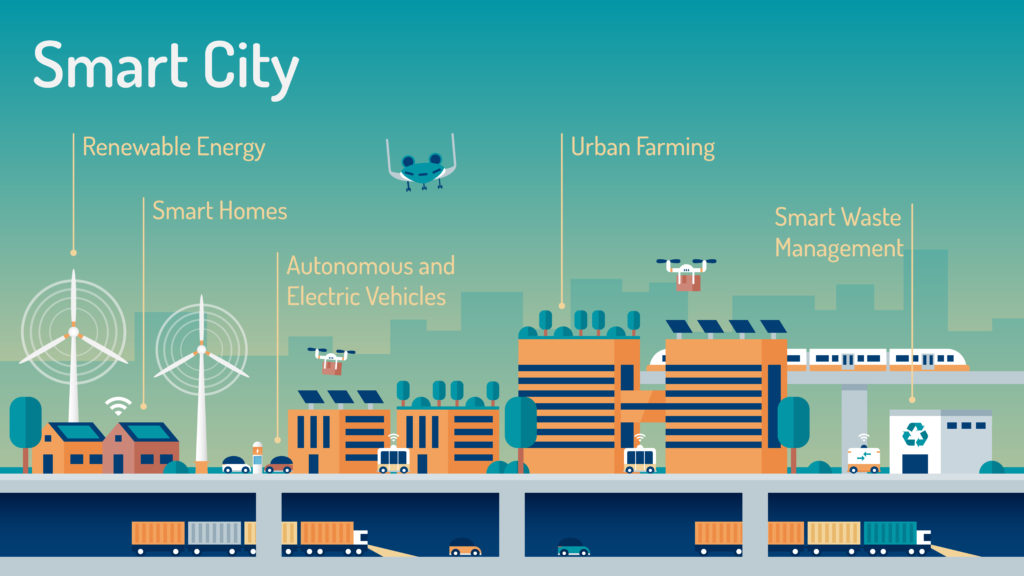LTE NB-IoT (LTE Narrowband Internet of Things) wireless network deployments carry many benefits and applications in today’s environment – such as low-cost devices, low power usage, extended battery life, high security, and high connection density. The future looks bright for LTE NB-IoT because of the trend towards lower prices, a growing device ecosystem, and the integration of the latest 5G technology and standards. These key attributes of LTE NB-IoT are especially important for Critical Infrastructure Industry (CII) organizations such as electric utility companies as they overhaul and modernize grid telecommunication networks for the 21st Century.

LTE NB-IoT is a communication standard that allows devices to communicate via a wireless network. LTE NB-IoT was specifically built for a machine to machine communications, otherwise known as the Internet of Things. LTE NB-IoT can be considered to be a type of LP-WAN (Low Power – Wide Area Network) which leverages long-range communications with a low bit rate. This limits the bandwidth to between 180kHz and 200kHz. The narrow bandwidth allows communications over a long range, and can support massive numbers of devices at low cost. Power levels are low, so the technology features low battery usage and the ability to support devices that frequently communicate. LTE NB-IoT is also known for being a very secure option for wireless networking. In June of 2013, the specification of NB-IoT was preserved in the 3rd Generation Partnership Project, otherwise referred to as 3GPP. LTE NB-IoT relies upon the same security protocols that have been painstakingly developed by and for large mobile wireless carriers. Thus, it benefits from the high levels of security established for this industry and business model. As such, LTE NB-IoT helps create a stable and safe environment for remote sensing and control devices. Some of the inherent security checks made standard by 3GPP are new authentication frameworks, better subscriber privacy, and service-based architecture, and interconnection security. All of these aspects contribute to the overall security of devices running on LTE NB-IoT.
The LTE NB-IoT standard contains a vast and growing ecology of endpoint devices. Examples include smart devices such as streetlights and metering often found in smart cities, smart parking meters, water conservation sensors, home and business alarm systems, and remote data collectors. Generally, these devices do not require large bandwidth and benefit from the efficiencies offered by LTE NB-IoT. This is especially beneficial in remote or difficult to reach locations where low battery usage is extremely important. LTE NB-IoT is also useful when devices are communicating from indoors or underground. By utilizing a narrow-bandwidth, and appropriate modulation techniques, the efficiency of transmission is very high and therefore greatly improves its overall range to 25 miles. This boosts reliability for endpoint devices that might otherwise struggle to get strong and stable signals, such as devices in tunnels, underground parking garages, windowless buildings, and underground data sensors.

One of the most appealing aspects of LTE NB-IoT is its low energy consumption. LTE NB-IoT utilizes a narrow bandwidth that supports a wide range of devices that have a data exchange rate of 250Kbps or less. Since the devices are exchanging low amounts of data at regular or triggered intervals, the battery life of endpoint devices is greatly lengthened. The endpoint devices that run on LTE NB-IoT are highly efficient and cut down on servicing for battery maintenance. This saves the owner of the endpoint device costly manual labor and in some cases, travel expenses to remotely located endpoint devices may be eliminated completely. It has been estimated that running on LTE NB-IoT can increase the longevity of a battery life, lasting as much as ten years or more. Add this savings to the already general low cost of devices and the appeal of NB-IoT increases. Chipset cost is expected to be less than $10 in volume, which keeps costs low for large scale deployments seeking to connect thousands of endpoints.
Through LTE NB-IoT’s smaller bandwidth, it is possible to accommodate a large number of connected endpoint devices. As of January 2020, it was estimated that over 100 million active connections were in place, globally. With trends indicating significant future growth, this number is only expected to continue to rise as LTE NB-IoT is integrated with 5G networks, whereby LTE NB-IoT will increase in speed and cost-effectiveness.

With this growth, new case studies demonstrating the flexibility of LTE NB-IoT will become increasingly available. Most recently, Jacksonville Electric Authority (JEA) has embraced LTE NB-IoT, deploying a test-network to maintain and monitor its emergency generators. The utility has also begun to expand this network to monitor water pressure, check wastewater levels, and communicate with leak detection sensors remotely. With this and other types of use, LTE NB-IoT wireless networks for CII organizations and electric utilities is expected to increase rapidly.
From private companies to major utilities, more and more companies are taking advantage of LTE NB-IoT for their endpoint devices. Benefiting from low cost, low battery usage, high efficiency, high security, and a wide availability of endpoint devices, LTE NB-IoT will become an increasingly important wireless network technology. In a rapidly developing tech industry offering many wireless options, use of LTE NB-IoT will grow rapidly due to its competitive advantages.
For more information on LTE NB- IoT visit: https://www.selectspectrum.com/available-spectrum/narrowband/lte-nb-iot
